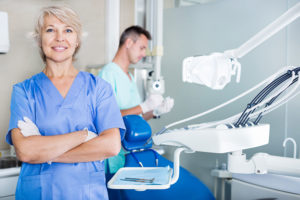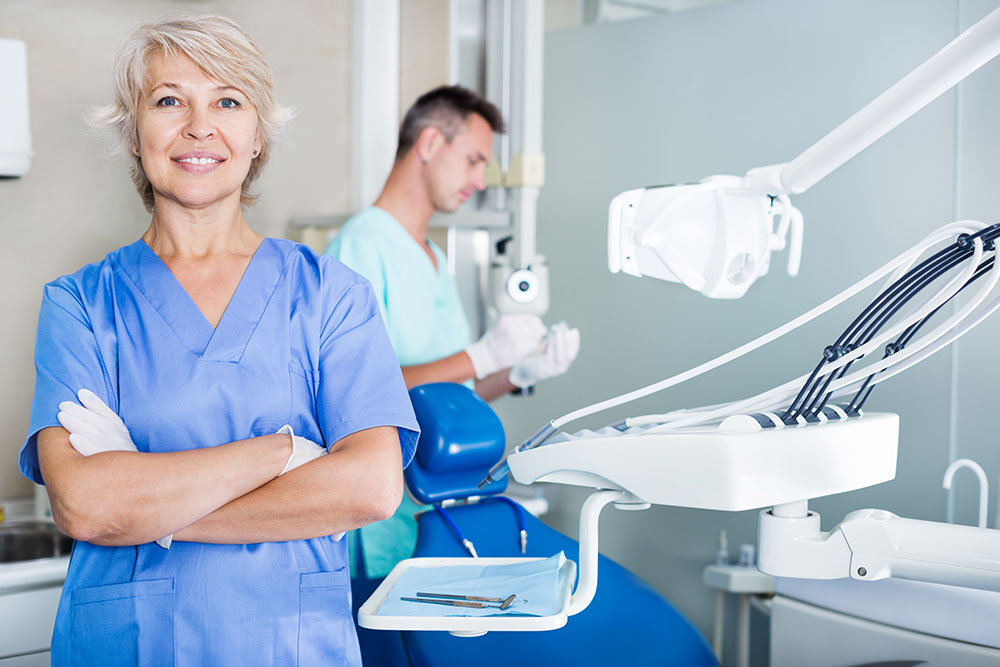Disclaimer: The information on our website is provided for general information purposes only. We make no representations or warranties of any kind, express or implied, about the completeness, accuracy, reliability, suitability or availability with respect to the website or the information contained on our website for any purpose. Any reliance on such information is therefore strictly at your own risk and we are not liable for any damages or losses arising out of or resulting from your reliance on any information contained on our website.
Among the nine recognized dental specialties by the American Dental Association, a prosthodontist focuses on repairing damaged teeth or replacing missing teeth with artificial devices such as dental implants, dentures, crowns, bridges, and veneers. Although lots of traditional dentists can provide these services too, prosthodontists have extensive experience working on delicate dental cases that need a specialist.
Watch a video to learn what a prosthodontist does:
How to Become a Prosthodontist

It’s projected that every year in the United States; almost 300,000 people have dental implants placed inside their mouths. Whether it’s due to an accident, to repair a congenital condition, or merely due to age, the reality is that cosmetic dentistry has risen significantly over the past few years. And believe it or not, the interest level of new college students who have ambitions of learning how to become a prosthodontist is also drastically on the rise.
You must first earn a bachelor’s degree. You’ll want to choose a bachelor’s degree that concentrates on general studies in biology, physiology, chemistry, physics, and human anatomy. You might also consider taking courses in psychology and sociology as these classes may help you gain a better understanding of people, the fears that habitually come with visiting a dentist, and how to offer a better bedside manner when working with patients.
Next, you must become a licensed DDM or DDS by attending dental school at an accredited Dental College or University. The first two years of study tends to focus on learning initial dental sciences and procedures that are inculcated in both the laboratory and in classroom settings.
The final two years transfer to clinical studies, where the soon-to-be dentists will take what they learned in the classroom, and apply it to practical experience as taught by dentists who have also received their Ph.D.’s. The students work in groups, where they learn how to diagnose and treat adult patients under direct supervision. Once the applicant has completed the dental school exams, they’ll become a DDS (Doctor of Dental Surgery) or a DMD (Doctor of Medicine in Dentistry).
To be licensed to practice dentistry in the United States, you must complete the National Board Dental Examinations, as overseen through the American Dental Association. There are 2 parts to this exam:
- A written examination, which is intended to test general knowledge of oral health.
- The clinical examination, which can only be taken once the candidate has successfully passed part one.
Each state has a specific licensing prerequisite to practice in their state and requires dentists to continue their education in order to maintain their license by attending educational classes or seminars.
Finally, in order to become a prosthodontist, you must complete a residency training directly after graduation from dental college and successful completion of the NBD exam. This is a 3 year program (separated into quarters, most times by the hospital or professional organization that offers the residency training). During this residency, candidates will receive intensive on-hands training in numerous sectors of this specialty including:
- Fixed prosthodontics
- Removable prosthodontics
- Implant prosthodontics
- Maxillofacial prosthetics
A common theme among prosthodontics residency programs is that they are often limited to very small group sizes. This is good news for residents, as they can build up close relationships with experienced board-certified mentors. The primary emphasis of the residency is on clinical practice; however, it’s also strong in research training.
The residency training will also focus on many other core studies that are relative to the overall practice of prosthodontics including:
- Biostatistics
- Dental laboratory techniques
- Medical oncology
- Otorhinolaryngology surgery
- Radiation oncology
Many prosthodontists work with oral cancer patients. As such, they need to have a clear understanding of how to correctly care for surgical patients and the interdisciplinary methods of treating those who are presently undergoing radiation therapy and chemotherapy.
Once the residency has been completed, you will have the chance to sit before the American Board of Prosthodontics to receive board certification. This examination is difficult, as it includes oral, written, and clinical examinations — all of which need to be passed with high standards to obtain the board certification.
You also have the option to continue your training in maxillofacial prosthodontics/prosthetics (or Oral and Maxillofacial Prosthodontics). This is a super-specialty of prosthodontics. All maxillofacial prosthodontists are first of all prosthodontists and then attain fellowship training for one year solely in maxillofacial prosthetics that embrace oral surgical and prosthodontic treatments.
Maxillofacial prosthodontists take care of patients with congenital failure of the head and neck area due to birth deficiency, cancer, surgery or trauma. Maxillary obturators, speech-aid prostheses (in the past known as Pharyngeal/soft palate obturators) and mandibular-resection prostheses are the most prevalent prostheses planned by maxillofacial prosthodontists.
Job Description of a Prosthodontist
Prosthodontists offer numerous specialized services that make use of state-of-the-art techniques in order to effectively repair congenital defects, including issues that arise from traumatic injury or neglect. Some of these services include:
- Proper fit and placement of crowns, bridges, and removable or solid dentures
- Fit and placement of dental implants
- Fix TMD-jaw (Temporomandibular Joint Disorders) joint issues, including sleep or snoring disorders
- Repairs from traumatic damages to the mouth and teeth
- Comprehensive oral cancer reconstruction surgery
As a prosthodontist, you may work within a very big dental practice or open your own specialized practice. You’ll devise treatment plans and work with other dentists to restore missing teeth and dental structures for either cosmetic or functional reasons. This process is done via the creation and implantation of crowns, bridges, and other prosthetic dental devices. A few of the conditions you may treat comprise Temporomandibular Joint Disorder (TMJ), sleep apnea and oral cancer.
Subspecialties in prosthodontics include esthetic dentistry, dentures and maxillofacial prosthodontics, dealing particularly with the rehabilitation of head, neck and facial abnormalities. Research and teaching are also career options for prosthodontists.
The responsibility of a prosthodontist’s care is best described as being the “oral architect” of the dental group. They design treatment plans and harmonize treatment sequences with dental or medical specialists and also with general dentists in order to provide the most comprehensive and complete care to patients.
The clinical expertise of the prosthodontist consists mainly of 2 components:
- Diagnosis, treatment planning and prevention. Identification of the cause of oral decay and corrosion is a key element to any dental treatment so as to stop the progression of the disease, decrease its impact on the oral environment, develop an effective treatment strategy and put a stop to future recurrence.
- Dental treatment with a wide collection of solutions including fillings, dentures, veneers, crowns, bridges, splints/night guards, implants and cosmetic dentistry.
Prosthodontist Career Video Transcript
Prosthodontists (a type of dentist) are like architects of the mouth. Instead of designing buildings, they create plans and structures for peoples’ jaws and teeth. Whether a patient’s jaws or mouth were damaged by an accident or disease, or developed incorrectly, these professionals restore lost function and a healthy appearance. Many people have heard of dental crowns, bridges, and dentures.
Prosthodontists use these and other structures to make it easier for patients to chew, speak, and smile! They must carefully measure a patient’s lower facial dimensions so any dental prosthetics or artificial parts fit comfortably. Prosthodontists may design and build prosthetics for patients or supervise their construction by dental technicians and lab workers. Prosthodontists often collaborate with other dentists and health care professionals to plan or provide treatment. They typically work full-time.
Prosthodontists typically need a doctoral degree from dental school, dentistry licensure, and three years of hands-on residency training. Candidates must also obtain specialty certification in prosthodontics. With so much education and training, your patients will know that you’ve had time to really sink your teeth into the latest industry developments.
Article Citations
Bureau of Labor Statistics, U.S. Department of Labor, Occupational Employment and Wages, May 2016, Prosthodontists.
National Center for O*NET Development. 29-1024.00. O*NET OnLine.
American Dental Association. Specialty Definitions and Education and Careers.
The career video is in the public domain from the U. S. Department of Labor, Employment and Training Administration.

